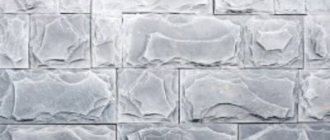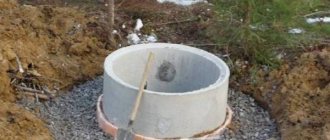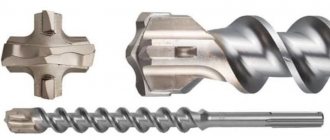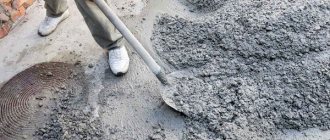Classification and characteristics
Dolomite crushed stone has a number of distinctive technical properties:
- The mass of 1m3 of dolomite crushed stone is 2650 kg.
- Hardness index – 3.5 – 4 units.
- The average weight of 1m3 is 1450 kg. This characteristic is important when calculating the properties of concrete mixtures.
- The flakiness of dolomite crushed stone is about 10–35%. This value reflects the flatness or elongation of the stones. These indicators affect compaction density and drainage properties. A cube-shaped stone, with a flakiness of up to 10%, is advantageous to use in the production of concrete, and a flatter stone is used as a cushion in the construction of highways.
- The amount of dust formations in dolomite crushed stone should not exceed 2%, clay and soil inclusions - no more than 0.25%.
- The degree of frost resistance of dolomite crushed stone is F150.
- Dolomite raw materials are characterized by high adhesion to most binders used in construction: gypsum, cement, polymers from the acrylic group, petroleum bitumen. Thanks to this property, it can be used as crushed stone for foundations or as backfill in the production of roofing felt.
Pure dolomite crushed stone is usually colorless or white. At the same time, the presence of inclusions of various minerals makes it possible to distinguish such types as yellow or gray crushed stone from dolomite. For example, the presence of warm shades in the mixture means that the rock contains iron hydroxide and clay particles. Gray, bluish-gray shades indicate the presence of manganese, strontium and barium oxide additives in the mixture. There are also natural samples of yellow-pink, pale pink, greenish and bluish shades. When chipped, such a stone has a glassy, pearlescent or matte sheen. The technical characteristics of dolomite crushed stone make it possible to use it in construction, for example, as a filler for foundations.
Properties
Properties of dolomite
- The properties of this mineral are very diverse. In construction, its fireproof properties and heat resistance are valued.
- Large pieces of this stone have found their use in landscape design and construction.
- In addition, it is very resistant and durable, withstands moisture and is able to maintain low temperatures.
Therefore, it will not be difficult to produce dolomite crushed stone from it. It is quite possible to purchase dolomite, but you need to keep in mind that it is sold individually - and only for landscape design.
Dolomite can be used as iron ore. It is quite rare to find it in exceptionally pure form. 90-95% is, in fact, carbonate, and the rest is called flux magnesium. This ore contains the maximum amount of magnesium, which is what ferroalloy plants operate on.
Production.
There are 3 ways to obtain dolomite crushed stone:
- Mining: the rock is blasted in quarries, after which it is delivered to a crushing plant, where it is processed to obtain certain fractions.
- Metallurgical: This method is used to produce slag waste, which is obtained during the main smelting process.
- Loose: dolomite crushed stone in the form of gravel obtained as a result of natural destruction of rocks or rolling down during scree.
How is it used?
Dolomite crushed stone
In general, dolomite crushed stone is the same as limestone crushed stone. Only the dolomite content should be 75 percent. As mentioned earlier, dolomite crushed stone is quite durable, almost like granite. Dolomite crushed stone is used in the production of concrete.
Its use indoors is much better, because such crushed stone is not capable of accumulating radioactivity. This granite rock has a certain radioactive background, which over time it is able to accumulate and even increase. Dolomite is a slightly different rock for which radioactivity is not a problem. The most practical is its use in the production of asphalt concrete. If the laid canvas is made from this particular asphalt, it will turn out lighter and will be better visible in the dark.
Here it is, dolomite crushed stone, the use of which is described above.
How to apply it correctly?
In general, dolomite crushed stone is the same as limestone crushed stone. Here the dolomite content should be seventy-five percent. It was already mentioned earlier that dolomite crushed stone is quite durable, almost like granite. Dolomite crushed stone is used in the production of concrete.
Using it indoors would be more appropriate, because such crushed stone cannot accumulate radioactivity. This granite rock has a certain radioactive background. It is precisely this that, after some time, she can not only accumulate, but also increase.
Dolomite is a slightly different rock for which radioactivity is not a problem. The most practical use would be to use it in the production of asphalt concrete. If the laid canvas is made from just this asphalt, it will be lighter in appearance and much better visible in the dark.
This is what dolomite crushed stone is, the use of which is described a little higher.
Area of use.
Due to its characteristics, dolomite crushed stone is widely used. Stone with a fraction of 5–20 mm is used as a filler for concrete grades M100-M300, on its basis the following is produced: a base on concrete piles; strip foundation; cast floors for installing massive equipment; beams and interfloor ceilings. The 20–40 mm fraction is used to create a monolithic foundation; bedding under alleys, as well as in garden plots for various household works. It can be purchased in bulk in cubic meters or packaged in 50 kg bags. The 40–70 mm fraction and non-standard sizes of dolomite crushed stone, including gravel, are used to form cushions under the solid base of the road surface. Limestone crushed stone is one of the best fillers for heavy concrete. This fact can be easily explained by excellent adhesion to cement and the cube-shaped shape of the grains. Crumbs are widely used for finishing work: in the design of premises and building facades. Dolomite crushed stone is in demand in design due to the fact that the range of shades of the stone from which dolomite crushed stone is made contains various colors: yellow, pink, beige, gray and others.
Advantages of dolomite crushed stone
Due to its distinctive qualities, dolomite crushed stone is a universal building material that is actively used in modern construction and production.
The main advantages of dolomite crushed stone are
- low level of natural radiation
- high frost resistance and strength
- low water absorption
- high adhesion
- fire resistance
- low bulk density coefficient
- excellent decorative properties
Which one should I use?
It is recommended to use grain fractions from 5 to 40 millimeters, which have the following advantages:
- high quality drainage;
- easy to compact;
- comfortable to walk on the surface;
- relatively low cost.
It is worth paying attention to the cleanliness of the stone. For work, use only washed crushed stone. If clay is present, dirt will be dragged into the house or left on garden paths.
You can save on the type of crushed stone . You should not overpay for granite stone, but choose gravel. If the site has a high groundwater level, then it is better to make a soft blind area. The stone allows water to pass through well.
You will find a lot of important and useful information on arranging a crushed stone blind area around the house here.
Natural stone in the interior
The use of natural materials is very popular in interior design. Natural beauty and amazing durability make natural stone finishing a suitable option for many interiors. This material is often used as follows:
- Manufacturing a countertop that combines high technical characteristics and an interesting appearance.
- Natural stone tiles used for the kitchen backsplash fill the wall space between the countertop and cabinets.
- Arrangement of the floor in the room.
- Stone can be used to highlight small areas in a room.
- Laying stone around the fireplace.
Natural stone in construction
Currently, a large number of people use natural materials for cladding buildings and beyond. Natural stone helps realize numerous design ideas. The material is used as follows:
- natural stone for facing the base;
- for laying paths, parking or recreation areas;
- arrangement of blind areas around buildings;
- laying out walls;
- erection of a fence.
Comparison of technical indicators
The flakiness of the material is determined by the content of flattened and needle-shaped grains. Flaky (needle-like) is a granule whose length is three times greater than its width. If the length is approximately 3 times greater than the thickness, it is plate-type.
Crushed stone is divided into groups according to flakiness indicators:
- I – up to 10 percent needle-shaped and plate-shaped. Used in the production of reinforced concrete concrete and road surfaces.
- II improved group - 10 - 15 percent. A universal material for all construction operations, incl. blind areas.
- III middle group – 15-25%. Differs in quality characteristics and is not suitable for many jobs.
- IV is 25 35 percent. Used in glass making.
- Group V – 35 – 50%. The low quality of the material allows it to be used only in the construction of temporary objects.
Density and strength depend on the origin of the material. The higher the strength value, the more versatile the crushed stone. Density and strength have a proportional relationship.
Strength characterizes the ability of granules to withstand mechanical loads. Frost resistance is measured in the freezing and thawing cycles of the stone. The material must not lose its technical characteristics.
The table shows the comparative characteristics of crushed stone:
| Performance characteristics | Crushed stone | |||
| Granite | Gravel | Limestone | Slag | |
| Strength M, kgf/cm2 | from 1200 to 1400 | from 800 to 1000 | from 400 to 600 | from 300 to 600 |
| Frost resistance F, number of cycles | 350 | 300 | 150 | from 100 to 200 |
| Bulk density, kg/m3 | 1,39 | 1,32 | 1,29 | 1,25 |
| Flakiness, % | from 15 to 20 | from 20 to 25 | from 15 to 20 | from 20 to 25 |
| Radioactivity, Bq/kg | 300 | 70 | 55 | 95 |











